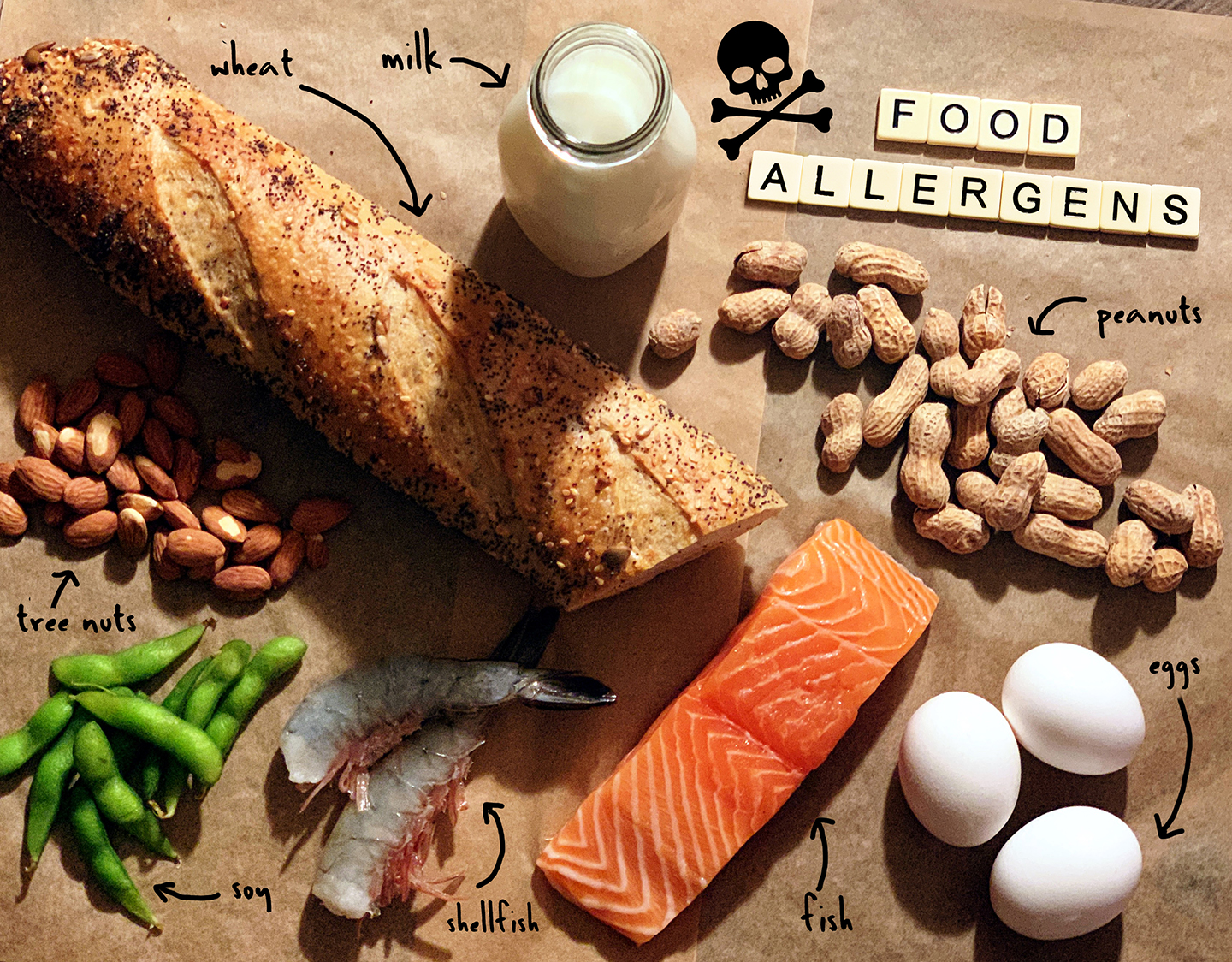
Twitter: @KianaGe5245146

Twitter: @sayaparali


Teens with food allergies combat unknown dangers on a daily basis
March 24, 2020
Her group of friends had planned one last late-night dinner before they embarked on their college adventures.
The trees that lined the street twinkled with lights as they walked toward the restaurant.
“Are there any nuts in the pasta?” she asked. She had asked this same question at least a thousand times before.
“No, no nuts,” the waiter said briskly.
She had nothing to worry about. Without a thought, she dipped her spoon gingerly into her first bite of the steaming noodles and let the satisfying sauce slide down her throat.
Approximately 32 million Americans are currently diagnosed with food allergies, and kids with food allergies are at risk every day.
In the U.S., 8% of children have at least one food allergy, a projected total of 5.9 million children, according to Pediatrics. Yet, on Halloween, people still give out candies that many children are allergic to. In everyday life, normal people do not cater to allergic kids’ needs, which leaves them in constant danger.
Likewise, simple things that everyone does like going to birthday parties, going out to eat, or even flying in an airplane are things kids with food allergies are not able to enjoy without extreme caution.
According to the Centers for Disease Control and Prevention (CDC), 150 to 200 people die every year from food allergies. Teenagers and young adults with food allergies are at the highest risk of fatal food-induced allergic reactions.
Allergies 101 by Kiana George
Riya Parlikar, an 8th grader from Fremont, is allergic to wheat, eggs, oats, and lentils. If she consumes any of these allergens, she risks having a severe anaphylactic reaction that could close her air passages in a matter of seconds. Because she was unable to eat what other kids could eat growing up, she developed social insecurities.
“When Riya was in elementary school, they would serve Goldfish crackers at her school, but since she was allergic, she couldn’t have any. She felt so left out at a point that she decided to try the Goldfish even though she was allergic to it,” said Viru Parlikar, Riya’s father.
She immediately started to have an allergic reaction and had to be sent home for the day to recover.
Aside from the development of social insecurities, kids with allergies can also be victims of bullying
In addition, kids also have to deal with taking on social responsibilities such as staying mentally tough through bullying.
One in 13 American children have a food allergy, and nearly a third of those say they have been bullied because of those allergies, some of which can be life-threatening, according to Fare, a Food Allergy Research & Education Institute.
“Surprisingly, it is often the adults that are the worst bullies! One teacher we had insisted on teaching every math lesson with food … she just did not get it,” Kristen Lee said.
It was only moments after her first bite that Ensley started to feel like she couldn’t breathe. She immediately felt dizzy; her throat started to tighten, hives were breaking out on her arms. She clutched her stomach as it started to cramp.
Teen brains are still in development, which means they are less likely to pause to consider the consequences of their actions. It is easy for them to eat something they are allergic to, especially if they are not cautious 24/7. According to the Food Allergy Research and Education organization, most allergic reactions occur as a result of ingesting foods that were thought to be safe.
When Kylie Cruz, a sophomore at Pinewood High School, was 12-years-old, her level of responsibility was put to the test when she joined a new basketball team and attended a team sleepover. During breakfast, a teammate pointed out she had consumed nuts.
“Both my mom and I forgot to mention I had a deadly allergy to nuts. The cinnamon buns that were served in the morning looked so good, and even though I’m usually really good about asking, I just wasn’t thinking about it that morning. We had to call 911, and I was rushed to the hospital in an ambulance,” Cruz said.
After that life-threatening experience, Cruz’s parents were afraid to let her go on a school trip to Asia.
“My school had a great opportunity to do volunteer work in Thailand. All my classmates were going, but my parents wouldn’t let me because Thailand uses peanut oil in nearly everything without labeling it, and they felt it was just too risky,” Cruz said.
Tasha Lee, a former student of Dana Hills School, has also been forced to be extremely cautious her whole life due to her life-threatening nut allergy. Her mom, Kristen Lee, found out she had a nut allergy when she consumed pesto sauce as a toddler. Lee had to be rushed to the hospital and treated with epinephrine, also known as an EpiPen, and other medications to help ease her symptoms.
Her mom described the challenges people with food allergies have to face regularly.
“Nuts are everywhere,” Kristen Lee said. “People with food allergies have to be very careful with personal products, as well as food. For example, almond oil and other nut oils are often found in skin lotions, shampoos, etc. Even toothpaste! With the popularity of more natural and organic ingredients in things these days, Tasha needs to be careful about these items as well. I just saw sponges in the grocery store that are made from walnut shells.”
As well as everyday occasions, the Lee family also learned that simple luxuries such as traveling poses many risks.
“Many airlines hand out peanuts as a snack or people bring it as a treat, the aroma coming from the peanuts can trigger Tasha’s reaction to nuts in the middle of the sky,” Kristen Lee said.
This means a great deal of extra work and planning to make traveling safe for Tasha.
Furthermore, sometimes just touching a food allergen can trigger a reaction. In one case reported by the Mayo Clinic, a young woman with a seafood allergy had to be taken to the emergency room after kissing her boyfriend, who had consumed a shrimp less than an hour earlier.
Her friend, Josh, frantically rifled through her purse to find her EpiPen. Apparently, there were traces of peanuts in the curry. As her throat continued to swell, her eyes started watering.
“I don’t want to die,” she gasped.
Just then, Josh stabbed the EpiPen deep into her thigh mercilessly.
There is currently no complete cure for food allergies; the only way to prevent a reaction is to avoid the allergen altogether.
When Tasha Lee was younger, her schools took her allergies very seriously and even provided a special table for kids with allergies to eat during lunch. The school also made the classrooms nut-free and had a supply of her meds in the medical office.
However, as children get older, there is less support from the schools.
A study by the Journal of Allergy and Clinical Immunology noted that elementary schools were more likely than middle schools and high schools to adopt policies prohibiting or restricting peanuts. For example, 97.9% of middle schools and high schools allowed students to bring peanuts from home, compared to 85.5% of elementary schools.
Starting in middle school, it was Tasha’s responsibility to carry several EpiPens and Benadryl at all times in a medical bag she keeps in her purse or backpack. She never leaves the house without them.
Aside from taking personal precautions, Kristen Lee said food labeling laws have also made it much easier for her daughter to stay safe.
“The new label laws about 10 years ago have made a world of difference. The top eight allergens must be noted on all food labels in clear language,” Kristen Lee said.
As the food allergy health issue becomes more known, newly-developed resources make life easier. Before eating out, Tasha can now go to a website called Allergy Eats to identify restaurants that have been rated by the allergy community.
Once she arrived at the hospital, panic ensued inside of her. What if I die right now? I didn’t get to say goodbye to my friends or family.
It felt like her head was going to explode into a million pieces. Just then, she heard the news from the nurse; she was going to be okay.
Food allergies are a growing health problem with the rate of affected people doubling approximately every 10 years. Several organizations are researching and testing various technologies to find new therapies to manage or prevent reactions.
Meanwhile, Riya Parlikar has been trying to minimize her immune system’s severe response to wheat for the past two years by introducing the allergen into her diet slowly over time, a process called desensitization.
The challenge during this process is gauging how much of the allergen can be ingested without triggering a severe response.
“During desensitization treatment, Riya went to a birthday party, had two slices of pizza instead of one, and she had the worst reaction ever since her body didn’t know what was going on,” Viru Parlikar said.
While desensitization can help short term, there is still no cure for allergies that are long-term. However, the Sean N. Parker Center for Allergy and Asthma Research at Stanford University hopes to change that; they are looking to develop a lasting cure by identifying the underlying immune mechanisms that cause allergies in the first place.
Their goal is to help get rid of people’s fear of foods they are allergic to. They run trials that result in one being able to eat small pieces of food without having an allergic reaction.
“At the end of the study we will do a real-world peanut trial, where they will consume a real peanut product, and the kid or adult will get to eat the food that they are allergic to and get over their fear,” said Dr. Meng Chen, a clinical assistant professor for the Sean N. Parker Center.
Through their treatments, they can help people get over their anxiety surrounding certain foods.
For Riya Parlikar, she believes that kids should learn about food allergies at school to help get rid of their anxieties and create a safer environment overall for kids with allergies.
“Kids at school with or without food allergies should both be educated on food allergies so that everyone will know how to deal with them,” Riya Parlikar said.
While there are many difficulties for kids, or anyone, with food allergies, as a whole, society is becoming better at helping those people. To learn more about food allergies, go to FARE.

Twitter: @KianaGe5245146
